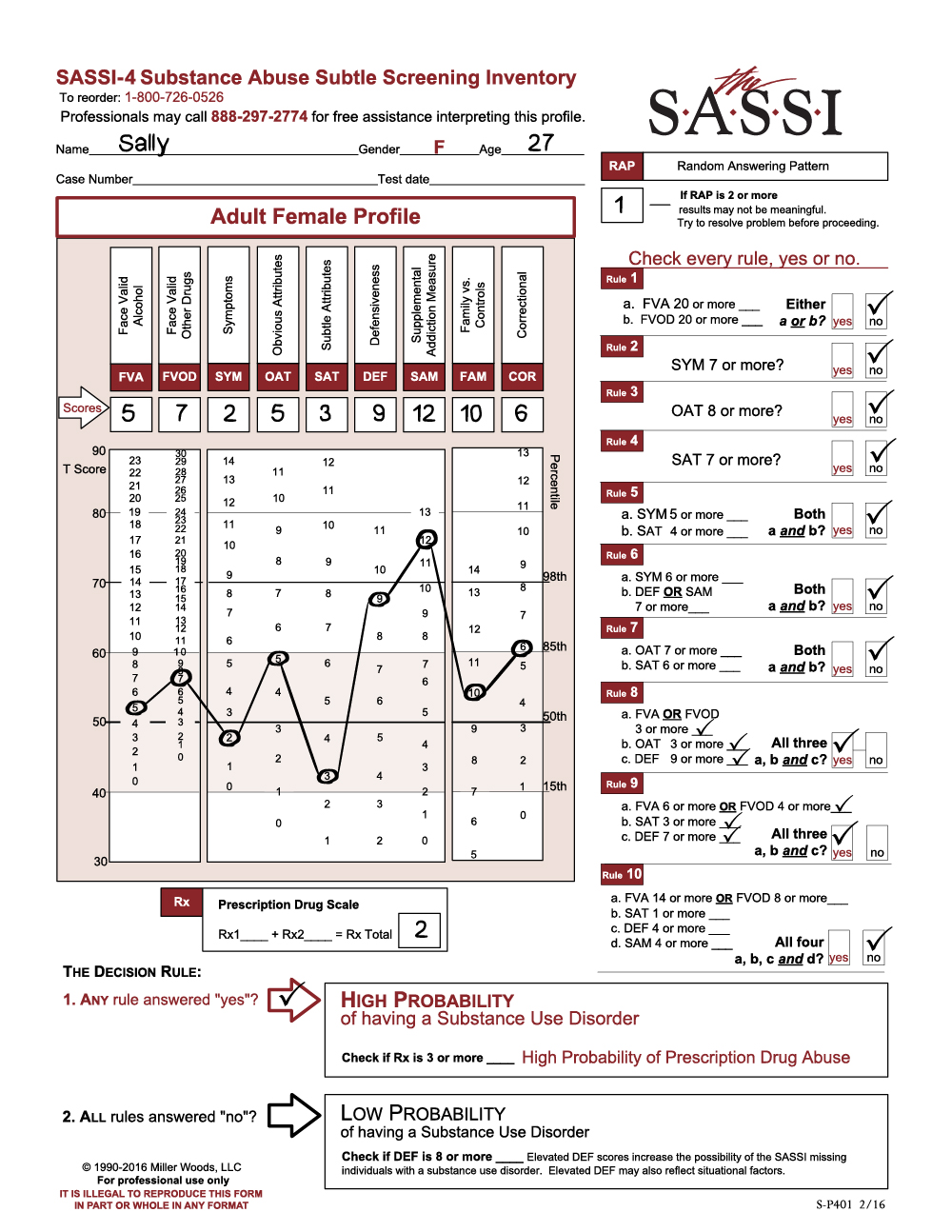This sample profile is about a 27-year-old, Sally, who is a single mother of two small children. Sally was ordered by the court to report for a substance abuse assessment following an arrest for illegal possession of a controlled substance. Sally is also being investigated by the county’s Child Protective Services Agency, who has placed her children into foster care pending the outcome of the case.
An initial review of Sally’s scores indicates that, although she apparently understood the SASSI items and most likely responded in a meaningful way (RAP=1), there is evidence of significant defensive responding (DEF=9). Despite her defensiveness, the results indicate that she has a high probability of having a substance use disorder (SUD) based on Decision Rule 8 and 9. To put it another way, there is a 93% chance that Sally will meet the DSM-5 diagnostic criteria for having a substance use disorder once a more comprehensive evaluation is completed.

For now, however, the SASSI has provided us with important information concerning Sally’s illegal act; her behavior is likely to be related to a serious addiction problem. In this light, we can now shift to looking for additional features on her profile that might help us to understand Sally better and develop a more empathic point of view. Learning more about her perspective and how she is dealing with this entire process, including the new information from the SASSI, certainly is one way to provide supportive and effective care to her during a mandated process of evaluation.
A prominent aspect of Sally’s SASSI results reflects her similarity to people with SUDs who were instructed to conceal and minimize any evidence of their substance use problems (DEF=9, SAM=12). In addition, an elevated DEF coupled with an elevated SAM indicates her defensiveness is related to her substance use. One inference that can be drawn from this is that she is likely to have significant difficulty in disclosing personal information about her misuse of substances, as well as other problematic behaviors. Other SASSI scale scores may be reflecting this mind set. For example, she does acknowledge some misuse of alcohol and other drugs but no more so than the average person in the general population (FVA=5, FVOD=7). Her SYM score of 2 is also average, indicating no significant similarity to people with substance use disorders who do report experiencing many of the behaviors correlated with addictions. However, given that each of these scales is derived from face valid items that can be easily manipulated, it would be reasonable to suspect that Sally may be underreporting or misrepresenting problems in each of these areas.
It is easy to imagine that Sally may harbor some resentment towards the evaluation process and the practitioners involved. After all, she stands to lose not only her freedom but her two children as well. Underlying the overt anger and resistance may be an extreme sense of fear, apprehension and powerlessness in the face of feeling helpless to influence decisions that will undoubtedly affect the rest of Sally’s life. When viewed from her standpoint, it then becomes easy to see Sally’s defensiveness as a somewhat natural response to the threat she must be feeling. It’s no wonder that she is having difficulty acknowledging her substance use problems.
If further diagnostic evaluation for substance use disorder does indicate that Sally has an SUD, the following treatment approaches may prove useful based on insight gained from Sally’s SASSI scores. Despite Sally’s lack of ability and willingness to recognize the impact of her substance use on her life, it is our ethical responsibility as counselors to use our knowledge, skills and experience to lead her to an accurate understanding of the nature of her substance use disorder. This should be accomplished in a climate of respect and acknowledgement of the pressures that she is currently facing. An attitude of respect is particularly important when attempting to build a therapeutic alliance with clients like Sally that are mandated for assessment and treatment.
One way to engender open communication in a respectful way is to invite Sally to join you in a process of reviewing her responses on the SASSI face valid items. Acknowledging that it is important for you to understand her point of view, perhaps asking for further clarification or details as you actively listen is one way to cultivate trust and rapport. This communicates genuine concern and interest that may help Sally feel supported and empowered as she describes her experiences. Empathic responses that demonstrate a good understanding of the difficulties she is facing while helping her to gain insight regarding the nature of her substance use problems would be useful in making her an active partner in creating a treatment plan that she can accept.
Another effective way to increase Sally’s awareness of her substance use problems while maintaining a respectful relationship is to provide cognitively based educational programming. Didactic presentations of alcohol and drug information generally are viewed by clients as less threatening and often tend to elicit a more favorable response. Sally may particularly benefit from content that describes the impact of substance abuse on families and how, with proper treatment and aftercare, recovering individuals are often able to be reunited with their children and other family members.
